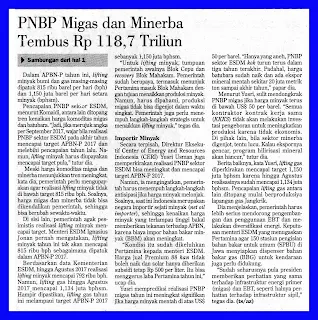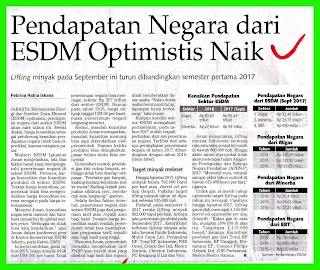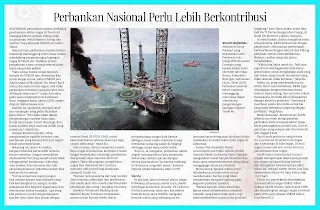The Ministry of Energy and Mineral Resources (ESDM) is optimistic that the target of non tax revenues (PNBP) in this year's ESDM sector is achieved, even exceeded. The realization of PNBP of oil and gas (oil and gas) as of September reached Rp 92.43 trillion or 96.7 percent of the target of Rp 95.6 trillion. While the realization of mineral and coal minerals (minerba) or mining reached Rp 25.73 trillion from the target of Rp 33 trillion (78%).
ESDM Minister Ignasius Jonan revealed that the realization of PNBP in the EMR sector shows a positive trend and in line with
target of APBN-P 2017.
"Realization of oil and gas PNBP as per September reached Rp 92 trillion more, by the end of the year may be Rp 120 trillion. Realization of PNBP Mineral and Coal even until the end of the year should be more than Rp 25 trillion or at least reach Rp 33 trillion, "said Jonan in Jakarta, Thursday (28/9).
Data from the Ministry of Energy and Mineral Resources show that the PNBP of the ESDM sector over the past three years tends to decline. In 2014, oil and gas PNBP reached Rp 320.25 trillion, in 2015 fell to Rp 122.52 trillion, and in 2016 fell again to Rp 83.83 trillion. While PNBP mining in 2014 reached Rp 34.40 trillion. That number in 2015 and 2016 fell to Rp 29.63 trillion and Rp 27.21 trillion respectively.
On the other hand, referring to the Ministry of Energy and Mineral Resources, New and Renewable Energy (EBT) revenues, although the numbers are still small. In 2014, PNBP EBT amounts to Rp 750 billion, rising to Rp 880 billion in 2015, and increasing again to Rp 930 billion in 2016. Until this September, the realization of PNBP EBT reached Rp 530 billion. Minister of EMR explained that the downward trend of realization of non-tax revenues is influenced by commodity prices.
"The government can not control the movement of commodity prices because it is entirely market dependent," he said.
Jonan added, in 2014 to 2016, world crude oil prices and coal weakened. But in 2017 improved and able to boost state revenues.
"The price of oil and gas commodities and minerals refer to international prices. So, global market price, so that we can not control, "he said.
Lifting Oil and Gas
Reforminer Institute Executive Director Komaidi Notonegoro estimates that the realization of the ESDM sector's non-tax revenues could exceed the target this year, with the target of oil and gas lifting achieved based on the APBN-P 2017 assumption. In APBN-P this year, oil and gas lifting is set at 815 thousand barrels per day (bpd) and 1.150 million barrels per day oil equivalent (bphsm). Achievement, PNBP of EMR sector, according to Komaidi, among others supported by the rising trend of oil and gas commodity prices and coal.
"So, if it refers to the figure as of September 2017, it is fair that the realization of the ESDM sector non-tax revenues at the end of the year reaches the revised budget target of APBN-P 2017 and exceeded last year's achievements. However, oil lifting should be pursued to achieve the target as well, "he said.
Although the price of oil and gas commodities and minerals shows an increasing trend, the government should strive for the realization of oil lifting is not below the target of 815 thousand bpd. You see, the price of oil and gas and minerba can not be controlled by the government, so that it can change at any time.
On the other hand, the government is rather pessimistic that the realization of oil lifting reaches the target. ESDM Minister Ignasius Jonan once said, oil lifting this year will not reach 815 thousand bpd as pegged in APBN-P 2017.
Based on data from the Ministry of Energy and Mineral Resources, until August 2017 the realization of oil lifting reached 792 thousand bpd. However, gas lifting until August 2017 reached 1.134 million bpdm. Almost ascertained, this year's gas lifting exceeded the target of APBN-P 2017 of 1.150 million bpdm.
"For oil lifting, the foundation of the government initially Cepu Block and recovery Mahakam block. The government has tried, including appointing Pertamina to enter the Mahakam Block with the aim of increasing oil production. However, it must be understood, oil and gas production can not be encouraged in a short time. The government also needs to take strategic steps to increase oil lifting, "he asserted
Importer of Oil
Separately, Yusri Usman, Executive Director of the Center for Energy and Resources Indonesia (CERI) also estimates that the realization of the ESDM sector's non-tax revenues could increase and reach the 2017 APBN-P target. However, he warned that the government should take anticipatory measures if oil prices soar. The problem is that Indonesia is a net oil importer, so that oil price hikes that are too high will put pressure on the state budget, as the cost of imported fuel oil (BBM) will increase.
"The condition has been complained of Pertamina to the minister of Energy and Mineral Resources.
The selling price of Premium 88 is not allowed to go up and diesel fuel is only given a fixed subsidy of Rp 500 per liter. It could reduce Pertamina's profit this year, "he said.
Yusri predicts the realization of oil and gas PNBP this year increased significantly if the price of crude oil above US $ 50 per barrel.
"Only the strange thing, the non-tax revenues of the ESDM sector has been falling steadily in the last three years. In fact, coal prices have gone up and there is export raw minerals of about 20 million metric tons by the end of the year, "he said.
According to Yusri, it is difficult to increase oil and gas PNBP if oil price continues below US $ 50 per barrel.
"All contracting contractors (KKKS) will not invest in drilling to increase production because it is not economical, while if the sector of Mineral and Coal is boosted, it would be funny if the exports are intense, the mineral downstream program will be destroyed," he said.
The good news is that gas lifting is estimated to reach 1.150 million bphsm target, as until August the realization has reached 1.134 million bpd. The achievement of gas lifting is supported by the field gas field of Jangkrik Field.
He explained that the government should more seriously encourage the development and use of EBT and diversify energy. The ESDM ministerial decree assigning Pertamina to 150 fuel stations for public (gas stations) in Java to prepare gas fuel dispenser (BBG) for vehicles also needs to be supported.
"The president should also pay the same attention to the primary energy infrastructure and the EBI as well as the attention to civil infrastructure," he said.
IN INDONESIA
PNBP Migas dan Mineral dan Batubara Mencapai Rp 118,7 Triliun
Kementerian Energi dan Sumber Daya Mineral (ESDM) optimistis target penerimaan negara bukan pajak (PNBP) di sektor ESDM tahun ini tercapai, bahkan bisa terlampaui. Realisasi PNBP minyak dan gas bumi (migas) per September mencapai Rp 92,43 triliun atau 96,7% dari target Rp 95,6 triliun. Sedangkan realisasi PNBP mineral dan batubara (minerba) atau pertambangan mencapai Rp 25,73 triliun dari target Rp 33 triliun (78%).
Menteri ESDM Ignasius Jonan mengungkapkan, realisasi PNBP di sektor ESDM menunjukkan tren positif dan sejalan dengan
target APBN-P 2017.
“Realisasi PNBP migas yang per September mencapai Rp 92 triliun lebih, pada akhir tahun mungkin bisa Rp 120 triliun. Realisasi PNBP Mineral dan Batubara pun sampai akhir tahun mestinya lebih dari Rp 25 triliun atau setidaknya mencapai Rp 33 triliun,” kata Jonan di Jakarta, Kamis (28/9).
Data Kementerian ESDM menunjukkan, PNBP sektor ESDM selama tiga tahun terakhir cenderung menurun. Pada 2014, PNBP migas mencapai Rp 320,25 triliun, pada 2015 turun menjadi Rp 122,52 triliun, dan pada 2016 turun lagi menjadi Rp 83,83 triliun. Sedangkan PNBP pertambangan pada 2014 mencapai Rp 34,40 triliun. Angka itu pada 2015 dan 2016 masing-masing turun menjadi Rp 29,63 triliun dan Rp 27,21 triliun.
Di sisi lain, merujuk data Kementerian ESDM, PNBP Energi Baru dan Terbarukan (EBT) naik meski angkanya masih kecil. Pada 2014, PNBP EBT berjumlah Rp 750 miliar, naik menjadi Rp 880 miliar pada 2015, dan naik lagi menjadi Rp 930 miliar pada 2016. Hingga September ini, realisasi PNBP EBT mencapai Rp 530 miliar. Menteri ESDM menjelaskan, tren penurunan realisasi PNBP dipengaruhi harga komoditas.
“Pemerintah tidak bisa mengendalikan pergerakan harga komoditas karena hal itu sepenuhnya tergantung pasar,” ujar dia.
Jonan menambahkan, pada 2014 hingga 2016, harga minyak mentah dunia dan batubara melemah. Namun pada 2017 membaik dan mampu mendongkrak penerimaan negara.
“Harga komoditas migas dan minerba mengacu pada harga internasional. Jadi, global market price, sehingga ini tidak bisa kita kendalikan,” tandas dia.
Lifting Migas
Direktur Eksekutif Reforminer Institute Komaidi Notonegoro memperkirakan realisasi PNBP sektor ESDM tahun ini bisa melampaui target, dengan catatan target lifting migas tercapai sesuai asumsi APBN-P 2017. Dalam APBN-P tahun ini, lifting minyak bumi dan gas masing-masing dipatok 815 ribu barel per hari (bph) dan 1,150 juta barel per hari setara minyak (bphsm). Pencapaian, PNBP sektor ESDM, menurut Komaidi, antara lain ditopang tren kenaikan harga komoditas migas dan batubara.
“Jadi, jika merujuk angka per September 2017, wajar bila realisasi PNBP sektor ESDM pada akhir tahun mencapai target APBN-P 2017 dan melebihi pencapaian tahun lalu. Namun, lifting minyak harus diupayakan mencapai target pula,” tutur dia.
Meski harga komoditas migas dan minerba menunjukkan tren meningkat, pemerintah perlu mengupayakan agar realisasi lifting minyak tidak di bawah target 815 ribu bph. Soalnya, harga migas dan minerba tidak bisa dikendalikan pemerintah, sehingga bisa berubah sewaktu-waktu.
Di sisi lain, pemerintah agak pesimistis realisasi lifting minyak mencapai target. Menteri ESDM Ignasius Jonan pernah mengatakan, lifting minyak tahun ini tidak akan mencapai 815 ribu bph sebagaimana dipatok dalam APBN-P 2017.
Berdasarkan data Kementerian ESDM, hingga Agustus 2017 realisasi lifting minyak mencapai 792 ribu bph. Namun, lifting gas hingga Agustus 2017 mencapai 1,134 juta bphsm. Hampir dipastikan, lifting gas tahun ini melampaui target APBN-P 2017 sebanyak 1,150 juta bphsm.
“Untuk lifting minyak, tumpuan pemerintah awalnya Blok Cepu dan recovery Blok Mahakam. Pemerintah sudah berupaya, termasuk menunjuk Pertamina masuk Blok Mahakam dengan tujuan menaikkan produksi minyak. Namun, harus dipahami, produksi migas tidak bisa digenjot dalam waktu singkat. Pemerintah juga perlu menempuh langkah-langkah strategis untuk menaikkan lifting minyak,” tegas dia
Importir Minyak
Secara terpisah, Direktur Eksekutif Center of Energy and Resources Indonesia (CERI) Yusri Usman juga memperkirakan realisasi PNBP sektor ESDM bisa meningkat dan mencapai target APBN-P 2017. Namun, ia mengingatkan, pemerintah harus menempuh langkah-langkah antisipasi jika harga minyak melonjak.
Soalnya, saat ini Indonesia merupakan negara importir sejati minyak (net oil importer), sehingga kenaikan harga minyak yang terlampau tinggi bakal memberikan tekanan terhadap APBN, karena biaya impor bahan bakar minyak (BBM) akan meningkat.
“Kondisi itu sudah dikeluhkan Pertamina kepada menteri ESDM.
Harga jual Premium 88 kan tidak boleh naik dan solar hanya diberikan subsidi tetap Rp 500 per liter. Itu bisa mengurangi laba Pertamina tahun ini,” ucap dia.
Yusri memprediksi realisasi PNBP migas tahun ini meningkat signifikan jika harga minyak mentah di atas US$ 50 per barel.
“Hanya yang aneh, PNBP sektor ESDM malah turun terus dalam tiga tahun terakhir. Padahal, harga batubara sudah naik dan ada ekspor mineral mentah sekitar 20 juta metrik ton sampai akhir tahun,” papar dia.
Menurut Yusri, sulit menaikkan PNBP migas jika harga minyak terus di bawah US$ 50 per barel.
"Semua kontraktor kontrak kerja sama (KKKS) tidak akan melakukan investasi pengeboran untuk meningkatkan produksi karena tidak ekonomis. Di pihak lain, bila sektor Mineral dan Batubara digenjot, tentu lucu. Kalau ekspornya gencar, program hilirisasi mineral akan hancur,” tutur dia.
Berita baiknya, lifting gas diperkirakan mencapai target 1,150 juta bphsm karena hingga Agustus realisasinya sudah mencapai 1,134 juta bphsm. Pencapaian lifting gas antara lain ditopang mulai berproduksiya lapangan gas Lapangan Jangkrik.
Dia menjelaskan, pemerintah harus lebih serius mendorong pengembangan dan penggunaan EBT dan melakukan diversifikasi energi. Keputusan menteri ESDM yang menugaskan Pertamina agar 150 stasiun pengisian bahan bakar untuk umum (SPBU) di Jawa menyiapkan dispenser bahan bakar gas (BBG) untuk kendaraan juga perlu didukung.
“Sudah seharusnya pula presiden memberikan perhatian yang sama terhadap infrastruktur energi primer dan EBI seperti halnya perhatian terhadap infrastruktur sipil,” tegas dia.
Investor Daily, Page-1, Friday, Sept 29, 2017









